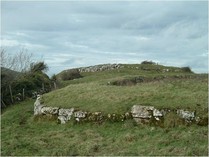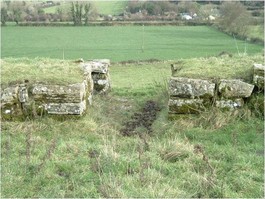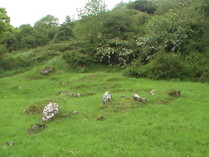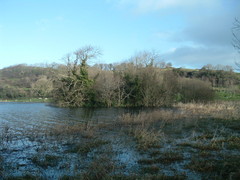Stone forts of Carraig Aille
 These massive stone forts were once up to 7 feet high topped with a palisade and inhabited from c. 7th to 10th centuries A.D. Carrig Aille II is the more perfect example, with an overall diameter of 47m and has an interesting entrance – partly paved for humans and cobbled for cattle. There are also six sets of steps on the southern wall leading to the rampart. The most interesting find during excavation was a hoard of Danish silver suggesting the presence of Vikings. Other finds included iron knives, bone combs, spindle whorls, querns, fragments of jet bracelets, stone axes and amber and glass beads.
These massive stone forts were once up to 7 feet high topped with a palisade and inhabited from c. 7th to 10th centuries A.D. Carrig Aille II is the more perfect example, with an overall diameter of 47m and has an interesting entrance – partly paved for humans and cobbled for cattle. There are also six sets of steps on the southern wall leading to the rampart. The most interesting find during excavation was a hoard of Danish silver suggesting the presence of Vikings. Other finds included iron knives, bone combs, spindle whorls, querns, fragments of jet bracelets, stone axes and amber and glass beads.

Entrance to Carraig Aille
The Spectacles
 This is one of the very early Christian field systems which have been identified. The group consists of four small fields. Each field contained a dwelling house and some outbuildings. They were enclosures for cattle and on occasions were tilled. The rough steps down to the lake are known as the “staighre” . People were living here when the Vikings launched their boats on Lough Gur in 926A.D.
This is one of the very early Christian field systems which have been identified. The group consists of four small fields. Each field contained a dwelling house and some outbuildings. They were enclosures for cattle and on occasions were tilled. The rough steps down to the lake are known as the “staighre” . People were living here when the Vikings launched their boats on Lough Gur in 926A.D.
Bolin island (crannog)
 Bolin island is man made and was built as a defended lake dwelling sometime between 500 and 1,000 A.D. by people who farmed the land near the lake. These artificial islands are called crannogs from “crann” the Irish word for tree. Bolin island is 30 m in diameter and would have been accessed by an underwater causeway. The bronze spearhead with gold inlay now in the Pitt Rivers Museum in Oxford was found beside Bolin Island.
Bolin island is man made and was built as a defended lake dwelling sometime between 500 and 1,000 A.D. by people who farmed the land near the lake. These artificial islands are called crannogs from “crann” the Irish word for tree. Bolin island is 30 m in diameter and would have been accessed by an underwater causeway. The bronze spearhead with gold inlay now in the Pitt Rivers Museum in Oxford was found beside Bolin Island.

Axehead
